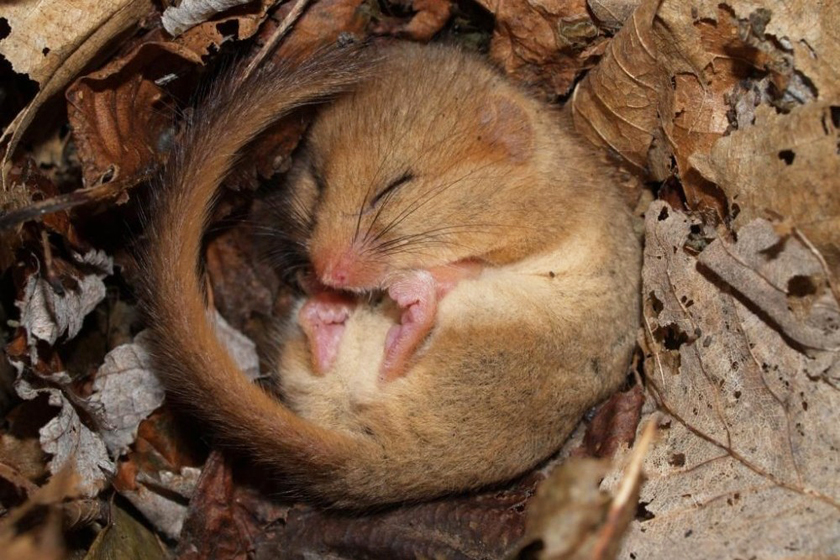
A new season, a New Year. This is a chance to blossom forth with new ideas and plans, or dig our heads deeper into the sand and perhaps disappear for a bit?
Many people are upset these days, with politics, or the weather, or their haircut, or any number of issues, and may want to take the next several years or so off. The scientific term is hibernation, and animals do it all the time, kind of like playing dead for a period of weeks, and even months. Our cuddly friends may have some tips on how us humans too could deal with our problems, and simply disappear and wake up in a new season—or year, or decade, or…
Deer mice do a cool thing, basically when the weather gets bad they embark on a seemingly endless series of multi-hour naps. They usually do this cozied up with a friend or two. This is actually called light hibernating, and seems like a good model for humans to follow. The message is simple, if you don’t like what’s going on, just go to sleep! And when you wake-up hopefully things will be better.
Poorwills, common in western states, are the only bird species that go into a true hibernation. “Drivers may spot the Poorwill itself sitting on a dirt road, its eyes reflecting orange in the headlights,” reads a post on Audubon’s website. “…with lowered body temperature, heartbeat, and rate of breathing, for days or even weeks at a time. Science discovered this in the 1940s, but apparently the Hopi people knew it long before that: their name for the Poorwill means ‘the sleeping one.’”
Ground squirrels do it right. They dig elaborate tunnels with different rooms, some for sleeping, some for storing food. Apparently, they even have bathrooms. Basically they set up a nice little hibernation pad, something in their blood shifts, and they’re out for up to nine months. Do they get up to pee in their hibernation bathrooms in the night? I wasn’t able to find out, but I think the answer is yes, or else why would they have built a hibernation bathroom?
Bats go into such a deep state of hibernation that they appear to be dead. Their heartrate drops from 400 to something like 25 beats per minute, and their breathing slows by so much that taking a single breath may take them an hour. Their hibernation pads tend to include cavities of large trees, caves, old mine shafts, abandoned wells, and your attic!
Hedgehogs can hibernate for up to six months. Their heart rate drops almost 90 percent. If their body temperature drops too low, they wake up, do some hedgehog calisthenics then go back to hibernation land. They can also hibernate when temperatures are exceedingly hot in summer, a trick called estivation.
In looking into this I realized that bears, the seemingly textbook hibernators, don’t actually hibernate at all. They go into what is called, a torpor. Which indeed means that they can be woken up much more easily than can a true hibernator. During their time of torpor they don’t eat or drink for about six months, and they rarely urinate or defecate. Somehow, female bears are able to give birth and nurse their young during this time. Imagine being able to hibernate away childbirth!
Very, very frightening the garter snake. According to livescience, “cold-climate garter snakes…hibernate in dens in large groups with hundreds of garter snakes sometimes found together…one den in Canada was the hibernation spot of more than 8,000 snakes.” And somehow they all get along while in their hibernation. In sleep there is peace. We could certainly learn some lessons from the garter snake.
But here is the ticket, the wood frog. No one does it quite like the wood frog. As the cold comes, wood frogs burrow inside logs or beneath rocks or leaf piles. Their hearts stop, they stop breathing and ice crystals form in their blood, which actually helps keep their cells warmer. Roughly two-thirds of their body water is completely frozen. “During its period of frozen winter hibernation, the frogs’ physical processes—from metabolic activity to waste production—grind to a near halt,” reads a blog on National Geographic’s website. According to work of researchers at Miami University in Ohio, the Alaskan wood frog can be frozen and then revived at temperatures as cold as 3.2 degrees Fahrenheit.
“The way wood frogs avoid freezing to death is due to so-called cryoprotectants—solutes that lower the freezing temperature of the animal’s tissues,” reads the site. “In most animals, prolonged exposure to subzero temperatures causes cellular shrinkage—a process in which the formation of ice in the tissues pulls water from the body’s cells, essentially sucking them dry and eventually killing the cell. But cryoprotectants help the cells resist that shrinkage.”
I think the lesson here is that there is some real science behind hibernation. And unfortunately our species must have slept late the day God handed out hibernation genes. Which means, for better or worse, you can’t play dead, you are going to have to face the world head on. And you can do it! Happy New Year!









